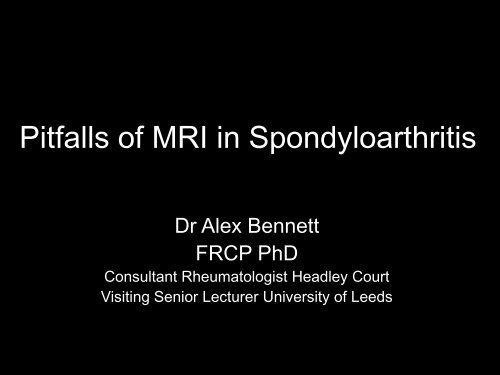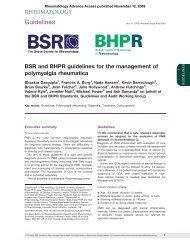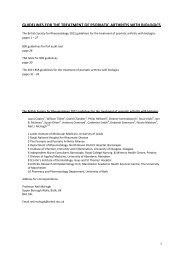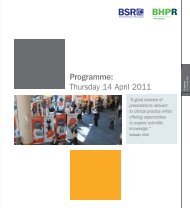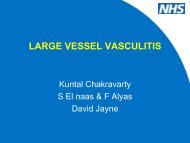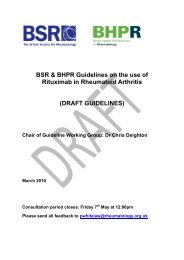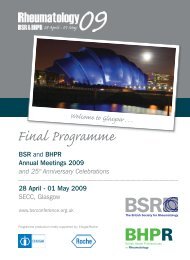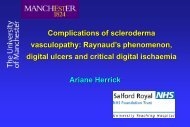Pitfalls of MRI in Spondyloarthritis
Pitfalls of MRI in Spondyloarthritis
Pitfalls of MRI in Spondyloarthritis
Create successful ePaper yourself
Turn your PDF publications into a flip-book with our unique Google optimized e-Paper software.
<strong>Pitfalls</strong> <strong>of</strong> <strong>MRI</strong> <strong>in</strong> <strong>Spondyloarthritis</strong><br />
Dr Alex Bennett<br />
FRCP PhD<br />
Consultant Rheumatologist Headley Court<br />
Visit<strong>in</strong>g Senior Lecturer University <strong>of</strong> Leeds
ASAS classification criteria for axial SpA<br />
(chronic back pa<strong>in</strong> >3 months, age at onset
<strong>Pitfalls</strong><br />
Conform<strong>in</strong>g with widely held but <strong>of</strong>ten <strong>in</strong>correct beliefs<br />
Request<strong>in</strong>g the Wrong Scans<br />
Mis-Diagnosis<br />
Technical Errors<br />
<strong>MRI</strong> <strong>in</strong>adequacies & Disease idiosyncrasies
Conform<strong>in</strong>g with Widely Held but<br />
<strong>of</strong>ten <strong>in</strong>correct Beliefs
The Radiologist is Always Right!<br />
What the **** is<br />
this?!<br />
This is an obvious<br />
case <strong>of</strong><br />
degenerative<br />
disease<br />
The request<br />
mentioned<br />
someth<strong>in</strong>g called<br />
Spondyloarthitis!?!
Don’t be a Lemm<strong>in</strong>g
Assume Noth<strong>in</strong>g
Make friends with your radiologist!
Request<strong>in</strong>g the Wrong Scan!
Protocol & Sequences<br />
• Whole Sp<strong>in</strong>e<br />
•4 sequences<br />
• cervico-thoracic – T1 and STIR<br />
• thoraco-lumbar – T1 and STIR<br />
•Sagittal only (to <strong>in</strong>clude pedicles and facets)<br />
• SIJs<br />
• 2 sequences<br />
• coronal oblique T1 and STIR<br />
• Contrast Not Required
35% AS<br />
38% axial-SpA<br />
NO ACTIVE <strong>MRI</strong> SACROILIITIS
25% AS patients<br />
SPINAL<br />
BUT NO<br />
ACTIVE SIJ LESIONS<br />
Images courtesy <strong>of</strong> Dr Alexander Bennett
Thoracic sp<strong>in</strong>e<br />
most<br />
sp<strong>in</strong>al lesions
Scan plann<strong>in</strong>g
Posterior Element Lesions<br />
STIR<br />
STIR
Inflammatory Lesions<br />
T1w<br />
STIR
Fatty Lesions<br />
T1w<br />
T1w
Mis-diagnosis
Sacroiliac Jo<strong>in</strong>ts
ASAS def<strong>in</strong>ition <strong>of</strong> “positive <strong>MRI</strong>”<br />
1. Sieper J et al. Ann Rheum Dis 2009;68:ii1-ii44
“Positive <strong>MRI</strong>”<br />
STIR<br />
STIR<br />
One slice sufficient<br />
2 slices required<br />
Image from ASAS handbook
Differential Diagnosis: Septic Sacroiliitis<br />
T1SE<br />
STIR
Differential Diagnosis: Insufficiency Fracture<br />
STIR<br />
T1SE
Sp<strong>in</strong>e
ASAS Def<strong>in</strong>ition <strong>of</strong> a Positive Sp<strong>in</strong>al <strong>MRI</strong><br />
• Inflammatory Romanus/corner lesions:<br />
• Fatty Romanus/corner lesions:<br />
≥2<br />
≥3<br />
• Posterior element lesions?<br />
ASAS Def<strong>in</strong>ition <strong>of</strong> a positive Sp<strong>in</strong>al <strong>MRI</strong>-In press
Differential Diagnoses<br />
A<br />
B<br />
C<br />
Degenerative Disease SpA Metastases<br />
Images courtesy <strong>of</strong> Dr Alexander Bennett
Septic Discitis v Spondylodiscitis<br />
T1<br />
STIR
Septic Discitis v Spondylodiscitis<br />
T1<br />
STIR
Degenerative Disease v Spondylodiscitis<br />
T1<br />
STIR
Artefact mimick<strong>in</strong>g sp<strong>in</strong>al lesions <strong>in</strong> SpA:<br />
haemangioma<br />
T1SE<br />
STIR
Technical Glitches
Artefacts<br />
• Coil effect<br />
– Spurious high signal at the lower SIJs<br />
• Anatomical artefact<br />
– Phase encod<strong>in</strong>g artefact – adjacent structures<br />
– Mimics – subchondral blood vessels
Phase-encod<strong>in</strong>g artefact : blood flow<strong>in</strong>g through great vessels<br />
T1SE<br />
STIR
<strong>MRI</strong> Inadequacies
HISTOPATHOLOGY v <strong>MRI</strong><br />
V<br />
8<br />
3<br />
Appel H et al. Arthritis Res Ther 2006
Disease Idiosyncrasies
Fluctuat<strong>in</strong>g Disease<br />
21%<br />
Basel<strong>in</strong>e<br />
12 months<br />
46%<br />
7%<br />
Marzo-Ortega, ARD 2009<br />
Basel<strong>in</strong>e<br />
12 weeks<br />
26%<br />
Stone et al, Rheumatology 2008<br />
Images Courtesy <strong>of</strong> Pr<strong>of</strong> J Sieper
“Negative” <strong>MRI</strong><br />
NOT necessarily<br />
“Normal” <strong>MRI</strong>
Summary<br />
Conform<strong>in</strong>g with widely held but <strong>of</strong>ten <strong>in</strong>correct beliefs<br />
Request<strong>in</strong>g the Wrong Scans<br />
Mis-Diagnosis<br />
Technical Errors<br />
<strong>MRI</strong> <strong>in</strong>adequacies & Disease idiosyncrasies
Thank You


